In the context of psychoanalytic theory, "Bilanggo Sa Dilim" provides an engaging psychological analysis of the main character Lito. His shift from an insecure photographer to a cunning kidnapper is motivated by unspoken wants and unsolved psychological issues. Lito's obsession with controlling Margie and later, Marissa can be interpreted as a manifestation of his inner turmoil and longing for dominance. His secluded beach house serves as a metaphorical battleground where his subconscious desires clash with external reality. Through psychoanalytic analysis, the film exposes the intricate workings of the human mind and the depths of human depravity.
The feminist viewpoint of "Bilanggo Sa Dilim" highlights the impact of the male gaze on female characters, revealing their struggle against patriarchal control. Margie and Marissa, the female protagonists, are initially depicted as vulnerable victims of Lito's patriarchal oppression. However, as the narrative unfolds, both women defy traditional gender roles and assert their agency in the face of adversity. Margie's cunning attempts to communicate with the outside world and Marissa's fearless resistance challenge the notion of women as passive objects of male desire. The movie criticizes how society keeps women in lower positions and shows how they keep going despite that. The film critiques societal norms that objectify women and emphasizes the importance of women asserting control over their lives.
From a Marxist lens, "Bilanggo Sa Dilim" can be interpreted as a critique of power dynamics within a capitalist society. Lito's obsession with possessing Margie and Marissa mirrors a desire for control, reflecting class struggles where the ruling class seeks dominance over the oppressed. The film showcases women's resistance against this oppressive system, challenging traditional gender roles. However, the limitations of their actions also reflect broader systemic issues, illustrating how social systems keep inequality going. The film promotes an analysis of the broader socio-economic systems contributing to the oppression of marginalized communities, particularly women.
Overall, the film exposes the reality wherein the struggles of women over society is still a continuous battle – one we must take note that it should not be like that. The rights of everyone should not be something that we should still be fighting for. It should be something that must already be served; free of any charges or struggle as it is a universal privilege we all should have an access to.

